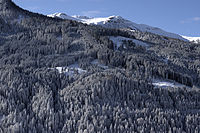Meteorology
Meteorological winter is the season having the shortest days and the lowest average temperatures, which have the coldest weather. This corresponds to the months of December, January and February in the Northern Hemisphere, and June, July and August in the Southern Hemisphere. The coldest average temperatures of the season are typically experienced in January in the Northern hemisphere and in June or July in the Southern hemisphere. Nighttime predominates the winter season, and in some regions it has the highest rate of precipitation as well as prolonged dampness because of permanent snow cover or high precipitation rates coupled with low temperatures, precluding evaporation. Blizzards often develop and cause many transportation delays. A rare meteorological phenomenon encountered during winter is ice fog, which comprises ice crystals suspended in the air; it occurs only at very low temperatures, below –30°C (–22°F).[1]Accumulations of snow and ice are mostly associated with winter in the Northern Hemisphere, due to the large land masses there. In the Southern Hemisphere, the more maritime climate and the relative lack of land south of 40°S makes the winters milder; thus, snow and ice are less common in inhabited regions of the Southern Hemisphere. In this region, snow occurs every year in elevated regions such as the Andes, the Great Dividing Range in Australia, and the mountains of New Zealand, and also occurs in the southerly Patagonia region of South America. Snow occurs year-round in Antarctica.
Period
Astronomically, the winter solstice, being the day of the year which has fewest hours of daylight, ought to be the middle of the season, but seasonal lag means that the coldest period normally follows the solstice by a few weeks. In the USA (and sometimes in Britain) the season is regarded as beginning at the solstice and ending on the following equinox — in the Northern Hemisphere, depending on the year, this corresponds to the period between 21 or 22 December and 20 or 21 March. In the UK, meteorologists consider winter to be the three coldest months of December, January and February. In Scandinavia, winter traditionally begins on 14 October and ends on the last day of February. In many countries in the Southern Hemisphere, including Australia, New Zealand and South Africa, winter begins on 1 June and ends on 31 August. In Celtic nations such as Ireland (using the Irish calendar) and in Scandinavia, the winter solstice is traditionally considered as midwinter, with the winter season beginning 1 November, on All Hallows, or Samhain. Winter ends and spring begins on Imbolc, or Candlemas, which is 1 or 2 February . This system of seasons is based on the length of days exclusively. (The three-month period of the shortest days and weakest solar radiation occurs during November, December, and January in the Northern Hemisphere and May through July in the Southern Hemisphere.)
Also, many[citation needed] mainland European countries tend to recognize Martinmas or St. Martin's Day (11 November), as the first calendar day of winter. The day falls at midpoint between the old Julian equinox and solstice dates. Also, Valentine's Day (14 February) is recognized by some countries as heralding the first rites of spring, such as flowers blooming.
In Chinese astronomy and other East Asian calendars, winter is taken to commence on or around 7 November, with the Jiéqì (known as 立冬 lì dōng—literally, "establishment of winter").
The three-month period associated with the coldest average temperatures typically begins somewhere in late November or early December in the Northern Hemisphere and lasts through late February or early March. This "thermological winter" is earlier than the solstice delimited definition, but later than the daylight (Celtic) definition. Depending on seasonal lag, this period will vary between climatic regions.
Cultural influences such as Christmas creep may have led to the winter season being perceived as beginning earlier in recent years, although high latitude countries like Canada and Russia are usually well into their real winters before the December solstice.






0 comments:
Post a Comment